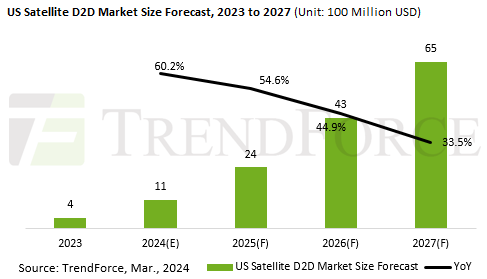Trends
US satellite D2D market expected to hit US$6.5 billion by 2027
The US satellite direct-to-device (D2D) market is expected to undergo significant growth, expanding from $430 million in 2023 to $6.5 billion by 2027 at a CAGR of 36%, according to TrendForce.

TrendForce highlights that Starlink, a leading US satellite operator, has progressively deployed residential satellite communication services in the US and the Philippines. To further increase user penetration, Starlink has announced a collaboration with telecom giant T-Mobile to offer satellite D2D services. With temporary certification granted by the FCC, Starlink is set to launch its direct-to-cell services in 2024. Initially, the service will only be offered to US regional users, allowing them to send and receive simple text messages in the 1.9 GHz frequency band through the satellite’s built-in eNodeB modem using 4G signals.
Additionally, following successful voice communication tests between the Blue Walker 3 satellite prototype and 5G smartphones, AST SpaceMobile secured approximately $207 million in investments from major firms like AT&T and Google. AST SpaceMobile is expected to launch the Bluebird satellite—equipped with D2D services—aboard a Falcon 9 rocket in 1Q24. This initiative, in collaboration with AT&T, aims to deploy the service in the US market. The US is anticipated to be a key region for telecom operators willing to expand satellite D2D services with satellite operators.
Taiwanese PCB and antenna manufacturers poised to enter satellite D2D supply chain
TrendForce notes that as an increasing number of satellite operators begin deploying D2D services, Taiwanese suppliers of key components can extend their manufacturing capabilities from ground stations to satellite component production, thereby entering the satellite D2D service supply chain.
For example, COMPEQ supplies HDI products exclusively to Starlink satellites, including those for direct-to-cell services. Meanwhile, Auden Techno is investing in the development of phase array antennas for C-band and L-band applications, targeting narrowband scenarios for Starlink’s D2D services.
Overall, Taiwanese manufacturers are not only assisting satellite operators in producing key components required for satellite D2D services but are also actively collaborating with these operators to test critical satellite components under various conditions, such as low-volume irradiation and extreme temperature variations. These tests are expected to meet the stringent demands of a harsh space environment—including low temperatures and high pressure—potentially leading to significant orders for critical components from major satellite operators. Trend Force




